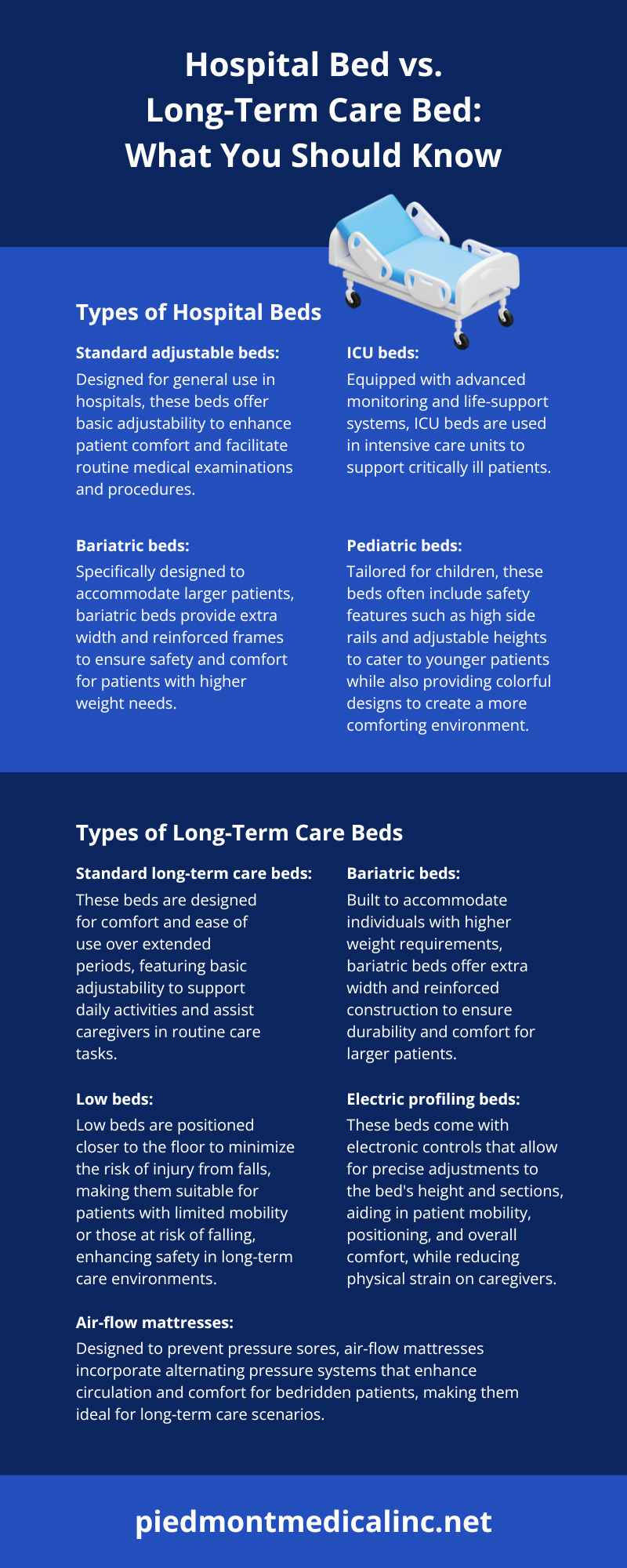Manufacturers create healthcare beds with unique features to meet the specific needs of different care environments. Hospital beds, for instance, may include advanced adjustability and technological integrations to support surgeries and acute care, while long-term care beds prioritize comfort and safety for chronic care. Using the right type of bed in its intended setting ensures optimal patient comfort and safety and assists in providing care. Learn what you should know about hospital beds versus long-term care beds to see how the appropriate bed can significantly improve patient well-being.
Design and Purpose
Hospital beds are crafted for acute care settings and equipped with features that support surgeries and emergency interventions. Hospital beds often include advanced adjustability with electronic controls to position patients precisely for surgical procedures and emergency care. Additionally, they may have integrated monitoring systems and specialized support surfaces to provide real-time patient data and enhance safety and comfort during complex medical interventions.
On the other hand, long-term care beds prioritize comfort and safety for patients with chronic conditions or disabilities, ensuring a conducive environment for ongoing care. The design of long-term care beds focuses on providing a homelike atmosphere to enhance the quality of life for patients who require prolonged care. These beds often feature softer aesthetics and user-friendly controls to promote ease of use.
Settings for Use
Hospital beds are predominantly used in acute care environments, such as hospitals and emergency rooms, where immediate medical intervention is required. These beds are essential in settings where rapid response and adaptability are critical to patient outcomes.
Long-term care beds are commonly found in nursing homes, assisted living facilities, and, increasingly, in home care settings. These beds support the daily needs of individuals with chronic conditions. Their design emphasizes stability and ease of use for patients and caregivers.
Functionality
Hospital beds offer advanced adjustability and control options, making them suitable for various medical procedures and patient needs. Features such as multiple elevation settings, tilt functions, and integrated scales allow healthcare providers to deliver precise and effective care. Hospital beds may have simple buttons for patients, caregivers, and visitors to use; however, they also include sophisticated controls that can be operated by healthcare professionals to manage critical patient conditions efficiently.
Conversely, long-term care beds emphasize ease of use and comfort adjustments, catering to daily living activities and general well-being. Long-term care beds are designed with features such as low height settings and easy-to-use side rails, which can be adjusted by patients or caregivers to enhance mobility and independence.
Types of Hospital Beds
Hospital beds come in a range of specialized designs to address the unique demands of patient care.
Here are just a few types of hospital beds:
- Standard adjustable beds: Designed for general use in hospitals, these beds offer basic adjustability to enhance patient comfort and facilitate routine medical examinations and procedures.
- ICU beds: Equipped with advanced monitoring and life-support systems, ICU beds are used in intensive care units to support critically ill patients.
- Bariatric beds: Specifically designed to accommodate larger patients, bariatric beds provide extra width and reinforced frames to ensure safety and comfort for patients with higher weight needs.
- Pediatric beds: Tailored for children, these beds often include safety features such as high side rails and adjustable heights to cater to younger patients while also providing colorful designs to create a more comforting environment.
Types of Long-Term Care Beds
Similarly, there are many designs for long-term care beds that meet the needs of users in facilities and home care settings.
Here are a few types of long-term care bedding:
- Standard long-term care beds: These beds are designed for comfort and ease of use over extended periods, featuring basic adjustability to support daily activities and assist caregivers in routine care tasks.
- Low beds: Low beds are positioned closer to the floor to minimize the risk of injury from falls, making them suitable for patients with limited mobility or those at risk of falling, enhancing safety in long-term care environments.
- Bariatric beds: Built to accommodate individuals with higher weight requirements, bariatric beds offer extra width and reinforced construction to ensure durability and comfort for larger patients.
- Electric profiling beds: These beds come with electronic controls that allow for precise adjustments to the bed’s height and sections, aiding in patient mobility, positioning, and overall comfort, while reducing physical strain on caregivers.
- Air-flow mattresses: Designed to prevent pressure sores, air-flow mattresses incorporate alternating pressure systems that enhance circulation and comfort for bedridden patients, making them ideal for long-term care scenarios.
Adjustable vs. Profiling Beds
Full-electric medical beds allow patients and care providers to adjust the bed’s positioning. However, some beds offer users a greater degree of control.
Adjustable beds are primarily designed for general use, offering basic position adjustments to enhance comfort and facilitate routine medical care, making them suitable for hospital and residential environments. In contrast, profiling beds feature advanced electronic controls that allow for precise adjustments to various sections of the bed, providing enhanced support and comfort in long-term care settings. While adjustable beds cater to a broad range of patient needs, profiling beds are ideal for patients requiring specific positioning for therapeutic reasons or those who are bedridden.
Cost
The cost of hospital beds is generally higher due to their advanced technology and features designed for critical care. These beds are equipped with sophisticated systems that allow for comprehensive patient monitoring and treatment, justifying their higher price point. Purchasing reconditioned hospital beds allows healthcare facilities to significantly reduce costs while still obtaining beds that offer essential features for patient care. These reconditioned options maintain high-quality standards and functionality, providing a budget-friendly solution without compromising on the critical requirements needed for effective treatment and monitoring.
In contrast, long-term care beds are designed to be more cost-effective, focusing on essential functionalities that support prolonged use without the need for high-end technology. However, long-term care facilities often operate on tighter budgets, making the affordability of the beds a crucial factor in their selection.
Understanding the differences between hospital beds and long-term care beds can help healthcare facilities and caregivers make informed choices that enhance the well-being of their patients and loved ones. Hospital beds, with their advanced features and adaptability, are essential in acute care settings where immediate medical intervention is crucial. Conversely, long-term care beds are designed with patient comfort and safety in mind, making them ideal for settings that provide continuous, supportive care. Select the right type of bed to ensure optimal patient comfort, care, and safety.



Recent Comments